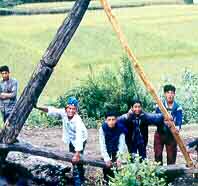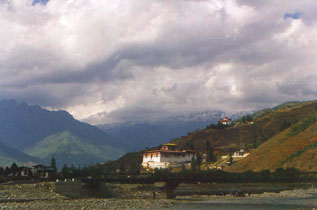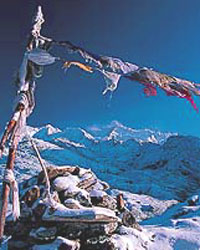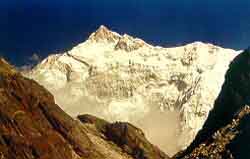| Mountaineering
Across the Himalayas - Part 1
|
|||||
The moon was still visible in the sky, although the sun had begun spreading its rays across the vast expanse of mountains around me. Strong and cold winds whirled around as I stood atop the famed Karakoram Pass (5,638 m). Inside me raged a storm of feelings and emotions - satisfaction, a sense of pride, some regrets, disappointments and of course thoughts of my dear ones.
|
Mountaineering
Adventure
Travelogues | ||||
On the first Leg ... Arunachal
It was on a wintry day on February 4 that we hit the trail from Bomdilla in Arunachal Pradesh. There was thick snow on the ground, but in our hearts small dreams were blooming just like the wonderful orchids in shades of purple and pink that we saw along the way. From Bomdilla we trekked via Rahung, Panchwati, Derang, Baisakhi and crossed the Tsela Pass (4,215 m). Though motorable, due to heavy snowbound conditions it was closed for vehicles. This pass had been the site of battle during the Chinese aggression. One of my most enchanting memories was the first sight of Tawang (Ta meaning horse and Wang meaning ruler) from a hill top. The town lay huddled under a blanket of snow with the picturesque roofs forming a symmetrical pattern. It was like a scene out of a Russian painting. A brief glimpse of the Tawang monastery and the handicraft center made me realise that here was a rich and colourful culture. However, we could not linger and had to make a quick march via Lumla to Blating, the gateway to Bhutan. In the Land of Monasteries - Bhutan The landscape bore winter's signature tune. It was visible in the icicles hanging from the branches, in the heavy snowbound passes and the chilly winds, but the warmth of the people was overwhelming. Simple gifts of roasted corn and suja or namkin chai touched my heart. As state guests we received valuable help from the District Collector of each state as well as from the local people. As we climbed through thick forest of Rhododendron, Juniper, Bamboo and Ferns above Tashiyangste, the climb got steeper towards Dong La. The descent from Dong La led us to Yanglapong. A beautifully painted monastery provided us shelter for the night. We trekked via Darchen Pong, visiting another monastery on the way to Tangmachhu. We enjoyed the different cultures of each new state. We proceeded towards Robong La. We reached Pelphu via Gortsham. However the weather packed up the next day and due to the heavy snow conditions we had to abandon the attempt to cross the Robong La. Our local porters were ill equiped to walk through waist deep snow. We returned back to Pelphu and trekked across the Yotang La (3,526 m) to Sengor. We enjoyed a steep trek across the Thrumsing La (3,758 m) before reaching Bhumtang. In Bhumtang we rested for a day. The day we reached Bhumtang the District Collector had organised a big party in our honour. There were over 100 people dancing and singing. We dressed up for the evening. Though we had walked around 10 hours on the trail having crossed Shelthong La (3,576 m), we danced hand in hand with the local men and women till midnight. Drinks were served, but most of us stuck to apple juice. Vegetarians have a tough time in Bhutan because the locals eat mainly non - vegetarian food. The delicacy of the region is pork. The locals expressed surprise that we had the strength to walk for so many months without having non-veg food as part of our diet.
In many ways trekking across Bhutan was a truly unique experience. We were in relatively unexplored territory with protected thick forests of rhododendron, magnolia and different species of bamboo. There was a magical, mystical feeling about the place. The colourful Buddhist flags were fluttering their prayers to the breeze. The distinctive architecture and symbols of Buddhism carved or painted on doors, panels and windows and the Chortens that dotted the country added a special charm. Of the nine passes that we crossed, Thrumsung La at 3,758 m was the highest. A high bamboo forest trail saw us leaving Bhutan and entering Sikkim at Lingtham after crossing Pangolakha (3,062 m).
|
|||||
Editor: Romola Butalia (c) India Travelogue. All rights reserved. |
|||||
 It had been a long journey. We had traversed the entire length of the Himalayas on foot in 198 days. Seven months ago I had set out from Bomdilla in Arunachal Pradesh. I was part of an eight member women's team "Indian Women's First Trans Himalayan Journey 1997". We were from different parts of India, having varied interests and different reasons for being on this journey.
It had been a long journey. We had traversed the entire length of the Himalayas on foot in 198 days. Seven months ago I had set out from Bomdilla in Arunachal Pradesh. I was part of an eight member women's team "Indian Women's First Trans Himalayan Journey 1997". We were from different parts of India, having varied interests and different reasons for being on this journey.
 I was excited as we would be entering a "foreign" country---the kingdom of monasteries where we would traverse from East to West, across 9 of its 17 districts, in 33 days. Each state has a different language though the customs are more or less the same. We entered Tashigang in the eastern side of Bhutan and walked across Lhuntshi, Bhumthang, Thongsa, Wangdi Phodrang, Timphu, Paro, Ha and Samtse, exiting from the western side at Sibsu.
I was excited as we would be entering a "foreign" country---the kingdom of monasteries where we would traverse from East to West, across 9 of its 17 districts, in 33 days. Each state has a different language though the customs are more or less the same. We entered Tashigang in the eastern side of Bhutan and walked across Lhuntshi, Bhumthang, Thongsa, Wangdi Phodrang, Timphu, Paro, Ha and Samtse, exiting from the western side at Sibsu.

 On our rest day, the District Collector generously made arrangements for us to drive around Bhumtang and visit some of the monasteries. There are several legends about these monasteries. We were also invited, as special guests, for a Bhutanese music programme that was played by a local troupe. We crossed Pele La (3,300 m) & Dochu La (3,080 m) before entering Timphu, the capital of Bhutan. In Timphu, we got a glimpse of a variety of the famous, colourful, useful and durable bamboo handicrafts. The trek across Pum La (3,050 m.) and Jilay La (3,780 m) was a good change after experiencing the hustle-bustle of Timphu. Golden Oriels and other birds were a treat to spot, as we gradually climbed to Pum La. The climb towards Jilay La was steep and an equally steep decent led us to Paro. The only airport in Bhutan is situated here. A trail through thick forest led us to the motorable pass at Chele La (3,395 m) in Western Bhutan. The pass led to Ha district. We could feel the change in the climate now. We crossed the Sele La (3,490 m) and headed for the Indian Border towards Samtse.
On our rest day, the District Collector generously made arrangements for us to drive around Bhumtang and visit some of the monasteries. There are several legends about these monasteries. We were also invited, as special guests, for a Bhutanese music programme that was played by a local troupe. We crossed Pele La (3,300 m) & Dochu La (3,080 m) before entering Timphu, the capital of Bhutan. In Timphu, we got a glimpse of a variety of the famous, colourful, useful and durable bamboo handicrafts. The trek across Pum La (3,050 m.) and Jilay La (3,780 m) was a good change after experiencing the hustle-bustle of Timphu. Golden Oriels and other birds were a treat to spot, as we gradually climbed to Pum La. The climb towards Jilay La was steep and an equally steep decent led us to Paro. The only airport in Bhutan is situated here. A trail through thick forest led us to the motorable pass at Chele La (3,395 m) in Western Bhutan. The pass led to Ha district. We could feel the change in the climate now. We crossed the Sele La (3,490 m) and headed for the Indian Border towards Samtse.
 In Sikkim, Spring began playing her tunes. On the way we had glimpses of the famous orchids of Sikkim in one of the local gardens. Gangtok, with its modern conveniences was a contrast to Bhutan. We had special permits to visit Nathula pass on the China border. Actually getting to see no-man's land and some Chinese posts across the Chumbi valley provided a ripple of excitement. A simple wooden board proclaimed in stark detail the strategic importance of the site in modern Indian history. An old fortress-like structure on the Indian side was a touching reminder of those who perished while guarding our frontiers. We took a rest day roughly every fortnight. This we utilised for washing our personal and group gear and making arrangements for supplies for the onward journey.
In Sikkim, Spring began playing her tunes. On the way we had glimpses of the famous orchids of Sikkim in one of the local gardens. Gangtok, with its modern conveniences was a contrast to Bhutan. We had special permits to visit Nathula pass on the China border. Actually getting to see no-man's land and some Chinese posts across the Chumbi valley provided a ripple of excitement. A simple wooden board proclaimed in stark detail the strategic importance of the site in modern Indian history. An old fortress-like structure on the Indian side was a touching reminder of those who perished while guarding our frontiers. We took a rest day roughly every fortnight. This we utilised for washing our personal and group gear and making arrangements for supplies for the onward journey.
 A distant view of Kanchanjunga, India's second highest peak, dominated the horizon at Gangtok. The trail to Gangtok and Yoksam was a trudge along a motorable road but we were soon able to put our mountaineering skills to use as we went over Rathong La (5,180 m), our high point in Sikkim. The Rathong peak (6,636 m) towered on one side of the pass. We climbed the pass from Yoksam via Bakhim and Dzongri La (4,320 m). We descended through the heavily crevassed slopes into Yarlung Glacier in Nepal. This was a trek that required proper mountaineering gear. We were grateful for the services of the local guide. We hired five yaks from Yoksam to carry our loads to the Base Camp. Accompanied by six Sherpas from Darjeeling, we crossed the glacier carefully as many crevasses were hidden under a deceptive cover of snow. We were suitably rewarded for our painstaking efforts when we came down to the Yalung glacier on the Nepal side. With its stupendous views it made for a most superb campsite. Getting a glimpse of the elusive snow leopard's footprints added to the thrill.
A distant view of Kanchanjunga, India's second highest peak, dominated the horizon at Gangtok. The trail to Gangtok and Yoksam was a trudge along a motorable road but we were soon able to put our mountaineering skills to use as we went over Rathong La (5,180 m), our high point in Sikkim. The Rathong peak (6,636 m) towered on one side of the pass. We climbed the pass from Yoksam via Bakhim and Dzongri La (4,320 m). We descended through the heavily crevassed slopes into Yarlung Glacier in Nepal. This was a trek that required proper mountaineering gear. We were grateful for the services of the local guide. We hired five yaks from Yoksam to carry our loads to the Base Camp. Accompanied by six Sherpas from Darjeeling, we crossed the glacier carefully as many crevasses were hidden under a deceptive cover of snow. We were suitably rewarded for our painstaking efforts when we came down to the Yalung glacier on the Nepal side. With its stupendous views it made for a most superb campsite. Getting a glimpse of the elusive snow leopard's footprints added to the thrill.